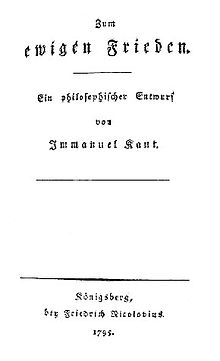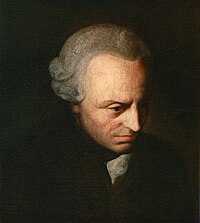You can help expand this article with text translated from the corresponding article in German. Click [show] for important translation instructions.
|
 Cover of the book | |
| Author | Immanuel Kant |
|---|---|
| Original title | Zum ewigen Frieden. Ein philosophischer Entwurf |
| Language | German |
| Subject | Philosophy |
| Set in | Konigsberg |
| Publisher | F. Nicolovius |
Publication date | 1795 |
| Publication place | Germany |
| Pages | 114 |
| Preceded by | Über den Gemeinspruch: Das mag in der Theorie richtig sein, taugt aber nicht für die Praxis (1793) |
| Followed by | Metaphysik der Sitten (1797) |
| Part of a series on |
| Immanuel Kant |
|---|
 |
|
Category • |
| Part of the Politics series |
| Republicanism |
|---|
|
|
Perpetual Peace: A Philosophical Sketch (German: Zum ewigen Frieden. Ein philosophischer Entwurf) is a 1795 book authored by the German philosopher Immanuel Kant.[1] In the book, Kant advances ideas that have subsequently been associated with democratic peace, commercial peace, and institutional peace.[2][3][4]
- ^ Kant, Immanuel (1795). Zum ewigen Frieden : ein philosophischer Entwurf (1 ed.). Königsberg: bey Friedrich Nicolovius. doi:10.3931/e-rara-25308.
- ^ Oneal, John R.; Russet, Bruce M. (1997). "The Classical Liberals Were Right: Democracy, Interdependence, and Conflict, 1950-1985". International Studies Quarterly. 41 (2): 267–294. doi:10.1111/1468-2478.00042. ISSN 0020-8833.
- ^ Russett, Bruce; Oneal, John R.; Davis, David R. (1998). "The Third Leg of the Kantian Tripod for Peace: International Organizations and Militarized Disputes, 1950-85". International Organization. 52 (3): 441–467. doi:10.1162/002081898550626. ISSN 0020-8183. JSTOR 2601398.
- ^ Deudney, Daniel H. (2007). Bounding Power: Republican Security Theory from the Polis to the Global Village. Princeton University Press. pp. 10, 155–156. ISBN 978-1-4008-3727-4.